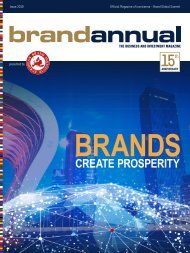iconannual2017
iconannual 2017 - The European Business and Investment Magazine "Brand together"
iconannual 2017 - The European Business and Investment Magazine
"Brand together"
Create successful ePaper yourself
Turn your PDF publications into a flip-book with our unique Google optimized e-Paper software.
Branding<br />
Foto: Renate Altenhofer<br />
Foto: Kellogg Graduate School of Management<br />
Bobby J. Calder<br />
is the Kellstadt Professor of Marketing at the<br />
Kellogg Graduate School of Management,<br />
Northwestern University, Evanston, IL USA.<br />
Intangible assets are now the<br />
key to economic growth and increasing<br />
corporate value. Unfortunately,<br />
as with intangible assets<br />
generally, it has historically been<br />
very difficult assign a value to<br />
brands. Everyone recognizes that<br />
brands are important. It is just<br />
that in the past we have had great<br />
difficulty in measuring the value<br />
of a brand. There has been little<br />
success in developing standards<br />
for brand value.<br />
The reason for this is that standards<br />
for intangible assets are in<br />
general difficult to develop and<br />
they are particularly difficult for<br />
brands because of the very nature<br />
of a brand. On the face of it everyone<br />
knows what a brand is and<br />
would recognize the American<br />
Marketing Associations definition<br />
of a brand as a “Name, term, design,<br />
symbol, or any other feature<br />
that identifies one seller’s good or<br />
service as distinct from those of<br />
other sellers.”<br />
This definition is good, so far<br />
as it goes, but it does not go far<br />
enough, for brands are really not<br />
things. Brands exist in the minds<br />
of customers. Names, symbols and<br />
the like are just ways of referring<br />
to brands, ideally in a way that<br />
itself influences how consumers<br />
think about the brand. The brand,<br />
however, is the ultimate meaning,<br />
or the idea, of the product in the<br />
consumer’s head. It is how the<br />
consumer thinks about the product,<br />
what he or she believes to be<br />
true about it.<br />
These beliefs can be functional<br />
in that they concern what the product<br />
does or how well it does something.<br />
Beliefs can also be emotional,<br />
how the brand makes the<br />
consumer feel. They can also be<br />
beliefs about what kind of person<br />
you are if you buy the brand. The<br />
brand can become linked to the<br />
consumer’s very concept of self.<br />
A brand is thus subjective, not<br />
objective. The key point to realize<br />
is that it is the consumer who<br />
owns the brand. The brand exists<br />
in their subjective world.<br />
Although brands are created<br />
by tangible investments in advertising<br />
and other marketing activities,<br />
the resulting brand is the idea<br />
or meaning that is created in the<br />
consumer’s mind. It is an intangible<br />
asset. Beyond this, and unlike<br />
software or patents, a brand<br />
only exists as a subjective state in<br />
the consumer mind. From a company’s<br />
point of view, the question<br />
becomes, how do you assess<br />
the value of a brand when brands<br />
are so intangible as to be essentially<br />
subjective. A standard must<br />
necessarily set a monetary valuation<br />
for something that exists in<br />
the consumer’s head.<br />
To do this we have to first<br />
evaluate the strength of the brand.<br />
A standard must specify the<br />
different kinds of indicators of<br />
brand strength that can be used to<br />
evaluate the power of the brand >><br />
The European Business and Investment Magazine iconannual 91


